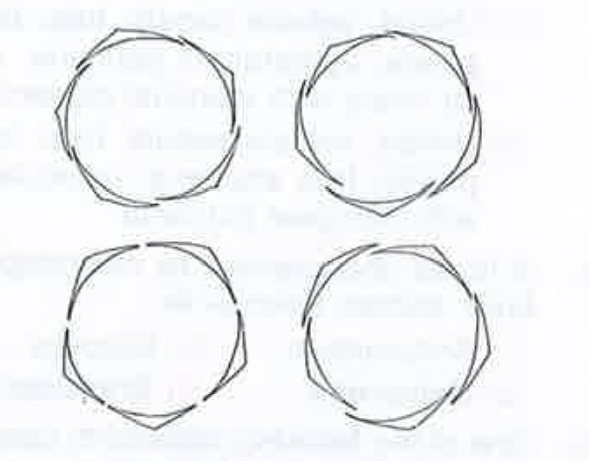Twisted aestivation is found in :-
Malvaceae
Asteraceae
Fabaceae
Mimosoideae
The correct Answer is:A
To determine which plant family exhibits twisted aestivation, we can follow these steps:
1. Understand the Concept of Aestivation:
- Aestivation refers to the arrangement of petals or sepals in a flower bud before it opens.
2. Identify the Types of Aestivation:
- There are four main types of aestivation:
- Valvate: Petals are adjacent to each other without overlapping.
- Twisted: Each petal overlaps the next one in a spiral manner.
- Imbricate: Petals overlap each other in a random fashion.
- Vexillary: One large petal (standard) and two smaller petals (wings) with a keel petal.
3. Analyze the Given Options:
- The options provided are:
- A) Malvaceae
- B) Asteraceae
- C) Fabaceae
- D) Mimosoideae
4. Recall Characteristics of Each Family:
- Malvaceae: Known for twisted aestivation, where petals overlap each other.
- Asteraceae: Typically exhibits valvate aestivation.
- Fabaceae: Known for vexillary aestivation.
- Mimosoideae: Generally does not exhibit twisted aestivation.
5. Conclude the Correct Answer:
- Based on the characteristics of the families, twisted aestivation is found in the Malvaceae family.
Final Answer:
Twisted aestivation is found in Malvaceae.
- Aestivation refers to the arrangement of petals or sepals in a flower bud before it opens.
- There are four main types of aestivation:
- Valvate: Petals are adjacent to each other without overlapping.
- Twisted: Each petal overlaps the next one in a spiral manner.
- Imbricate: Petals overlap each other in a random fashion.
- Vexillary: One large petal (standard) and two smaller petals (wings) with a keel petal.
- The options provided are:
- A) Malvaceae
- B) Asteraceae
- C) Fabaceae
- D) Mimosoideae
- Malvaceae: Known for twisted aestivation, where petals overlap each other.
- Asteraceae: Typically exhibits valvate aestivation.
- Fabaceae: Known for vexillary aestivation.
- Mimosoideae: Generally does not exhibit twisted aestivation.
- Based on the characteristics of the families, twisted aestivation is found in the Malvaceae family.
Twisted aestivation is found in Malvaceae.
Topper's Solved these Questions
- STRUCTURAL ORGANISATION IN PLANTS (MOPRHOLOGY OF FLOWERING PLANTS & ANATOMY OF FLOWERING PLANTS)BOOK - ALLENCHAPTER - STRUCTURAL ORGANISATION IN PLANTS (MOPRHOLOGY OF FLOWERING PLANTS & ANATOMY OF FLOWERING PLANTS)EXERCISE - EXERCISE -II (Previous Year Questions)
1 Videos
- STRUCTURAL ORGANISATION IN PLANTS (MOPRHOLOGY OF FLOWERING PLANTS & ANATOMY OF FLOWERING PLANTS)BOOK - ALLENCHAPTER - STRUCTURAL ORGANISATION IN PLANTS (MOPRHOLOGY OF FLOWERING PLANTS & ANATOMY OF FLOWERING PLANTS)EXERCISE - AIPMT 2006
5 Videos
- STRUCTURAL ORGANISATION IN PLANTS (MOPRHOLOGY OF FLOWERING PLANTS & ANATOMY OF FLOWERING PLANTS)BOOK - ALLENCHAPTER - STRUCTURAL ORGANISATION IN PLANTS (MOPRHOLOGY OF FLOWERING PLANTS & ANATOMY OF FLOWERING PLANTS)EXERCISE - EXERSICE-1 (Roots to Inflorescence)
28 Videos
- STRATEGIES FOR ENHANCEMENT IN FOOD PRODUCTION & ANIMAL HUSBANDRYBOOK - ALLENCHAPTER - STRATEGIES FOR ENHANCEMENT IN FOOD PRODUCTION & ANIMAL HUSBANDRYEXERCISE - Question
47 Videos
- STRUCTURAL ORGANISATION OF ANIMALS (ANIMALTISSUE)BOOK - ALLENCHAPTER - STRUCTURAL ORGANISATION OF ANIMALS (ANIMALTISSUE)EXERCISE - S
32 Videos
Similar Questions
Assertion: In imbricate aestivation, out of five petals, one is completely internal, one is completely external and in each of the remaining three petals, one margin is internal and the other is external
Reason:Ascending imbricate aestivation is found in Cassia and gulmohur.
View SolutionWhich type of aestivation is found in Pea?
View SolutionTwisted aestivation and axile placentation are found in:
View SolutionVexillary aestivation is not found in the flowers of
View SolutionGo through the following matches
(i) China rose - Twisted aestivation
(ii) Calotropis - Valvate aestivation
(iii) Gulmohur - Ascending imbricate aestivation
(iv) Pea - Descending imbricate aestivation
Which of these are correct ?
View SolutionWrite floral formula for a flower which is bisexual, actinomorphic sepals five, twisted aestivation, petals five valvate aestivation, stamens six, ovary tricarpellary, syncarpous , superior, trilocular with axile placentation.
View SolutionWhich of these properties are seen in Hibiscus rosa - sinensis ?
(i) Leaves with alternate phyllotaxy
(ii) Polycarpellary syncarpous inferior ovary
(iii) Twisted aestivation in petals
(iv) Basal placentation of ovules
View SolutionWhich type of aestivation is shown in the diagram ?

View SolutionGo through the following matches
(i) Cassia - lmbricate aestivation
(ii) Lady finger - Twisted aestivation
(iii) Calotropis - Vexillary aestivation
(iv) Lily - Epipetalous stamens
(v) Alstonia - Whorled phyllotaxy
(vi) Silk cotton - Pinnately compound leaf
Find out the correct matches
View SolutionLarge posterior petal is chracteristic to vexillary aestivation found in members of
View Solution
